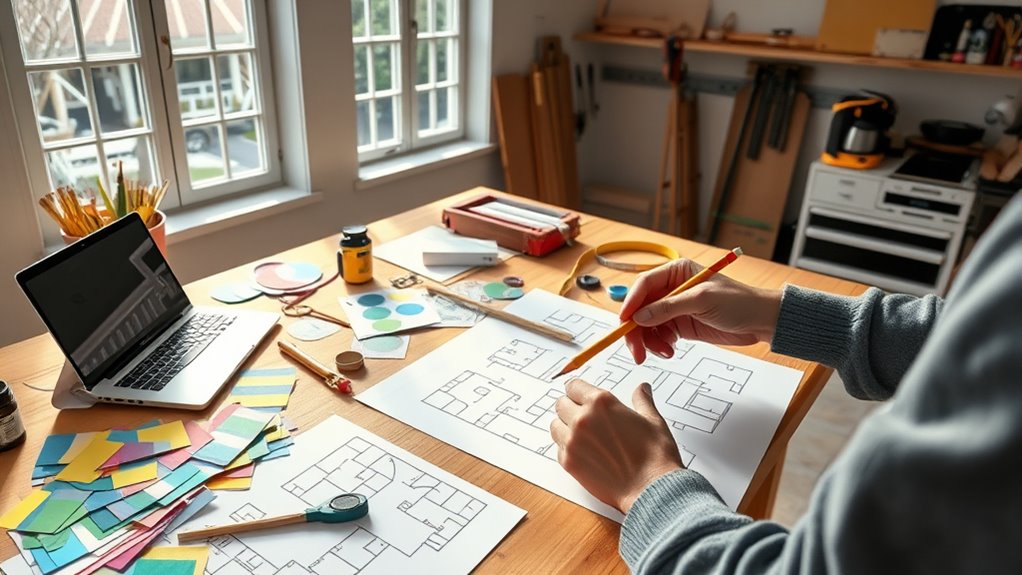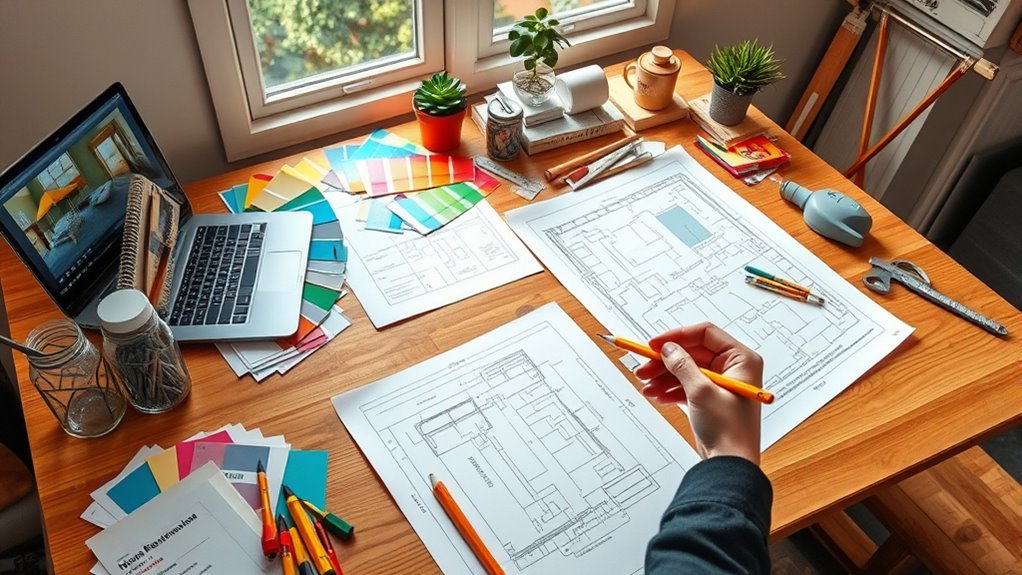To plan a home project successfully, start by setting a realistic budget that includes a contingency fund for surprises. Create a detailed timeline with manageable steps, built-in buffers for delays. Prioritize tasks based on importance and dependencies, sequencing them carefully. Communicate clearly with professionals and stay flexible to adapt as needed. Mastering these steps guarantees your project stays on track—and there’s plenty more to discover as you go forward.
Key Takeaways
- Set a realistic budget, including a contingency fund, to guide material and labor choices.
- Develop a detailed timeline with buffer time for permits, delays, and unexpected issues.
- Prioritize tasks based on dependencies and sequence work to ensure smooth progress.
- Communicate clearly with professionals about budget, timeline, and project expectations.
- Stay flexible and adaptable to handle unforeseen challenges without losing sight of goals.
Effective Planning: Budget, Timeline, and Task Management

Starting a home project can be exciting, but careful planning is vital to guarantee everything goes smoothly. One of the first things you need to focus on is setting a realistic budget. Knowing your budget considerations helps you determine what’s feasible and guides your decisions on materials, labor, and unexpected expenses. Be honest about how much you’re willing to spend and include a contingency fund—typically around 10-15% of your total budget—to cover unforeseen costs. This way, you won’t have to hit pause when surprises pop up, and you’ll keep your project financially on track.
Setting a realistic budget with a contingency fund keeps your home project on track financially.
Alongside your budget, managing your timeline is equally important. Creating a clear schedule helps you stay organized and ensures the project advances steadily. Start by breaking down the entire project into smaller, manageable steps, and assign estimated timeframes to each. Be realistic—overly ambitious timelines can lead to frustration and rushed work, which might compromise quality. Factor in potential delays, such as waiting for permits, delivery issues, or weather conditions, and build some buffer time into your plan. Regularly revisiting and adjusting your timeline keeps you on course and prevents small setbacks from snowballing into major delays.
Once you’ve got a handle on your budget and timeline, you should prioritize tasks based on importance and dependencies. For example, if you’re renovating a kitchen, you’ll want to handle electrical and plumbing work before installing cabinets or countertops. This sequencing minimizes rework and keeps your project moving forward efficiently. Keeping a detailed checklist or a project management tool can help you track progress and deadlines, making sure nothing slips through the cracks.
Communication is another key element. If you’re hiring professionals, clearly communicate your budget constraints and timeline expectations from the start. This transparency helps set realistic boundaries and fosters a collaborative relationship. Regular updates and check-ins with contractors or suppliers will keep everyone aligned, prevent misunderstandings, and allow you to address issues as they arise.
Finally, stay adaptable. Even with meticulous planning, unexpected challenges can occur. Maintaining a flexible mindset allows you to adapt without losing sight of your overall goals. Be prepared to reallocate resources or adjust your schedule if needed. Proper planning around your budget considerations and timeline management not only keeps your project on track but also makes the entire process more enjoyable, giving you peace of mind that your home improvement will be a success.
Frequently Asked Questions
How Do I Prioritize Which Home Projects to Start First?
Start by evaluating your home’s most urgent needs and your budget considerations. Identify projects that will have the biggest impact or improve safety first. Consider your timeline management — prioritize tasks that fit your schedule and avoid delays. Break down larger projects into smaller steps, and tackle those with the highest priority early on. This approach ensures you focus on what matters most, balancing urgency, budget, and time effectively.
What Tools Are Essential for Planning a Home Project?
A tool is only as good as its use, so start with essential items like a tape measure, a notebook, and a calculator. These help you track your budget considerations and organize your design inspiration. Don’t forget a digital device with project management apps to stay on top of deadlines. With these tools, you’ll keep your project on track and turn your vision into reality efficiently.
How Can I Involve Family Members in the Planning Process?
You can involve family members by encouraging family collaboration early in the decision-making process. Hold a brainstorming session where everyone shares ideas and concerns, making certain each person feels heard. Use visual aids like mood boards or plans to facilitate discussion, and assign tasks based on interests or strengths. This approach fosters teamwork, guarantees everyone’s input shapes the project, and makes the planning more enjoyable and inclusive.
What Are Common Pitfalls to Avoid During Planning?
You should avoid common pitfalls like poor budget planning, which can lead to unexpected expenses, and rushing contractor selection, risking subpar work. Always set a realistic budget, including a contingency fund, and thoroughly research and interview contractors before hiring. Don’t skip detailed planning stages or overlook permits and timelines. Staying organized and vigilant helps guarantee your project stays on track, saving you time and money.
How Do I Adapt Plans if Unexpected Issues Arise?
Imagine your plans as a roadmap, but unexpected issues like detours appear. You adapt by employing contingency planning, quickly evaluating the problem, and adjusting your timeline or scope. Keep your budget flexible, allowing for unforeseen costs. Communicate with contractors and suppliers to find solutions promptly. This proactive approach ensures you stay on track, turning surprises into manageable bumps rather than obstacles, so your project continues smoothly despite surprises.
Conclusion
By now, you see that effective planning isn’t just about setting a budget or timeline—it’s about understanding how these elements intertwine. Some say a detailed plan guarantees success, but research suggests flexibility often leads to better outcomes. Keep your goals adaptable, revisit your plan regularly, and trust that a well-thought-out approach increases your chances of completing your project smoothly. Remember, even the best plans require adjustments—embrace them as part of the process.










